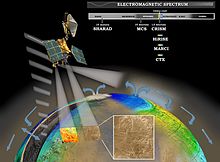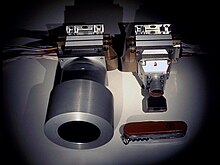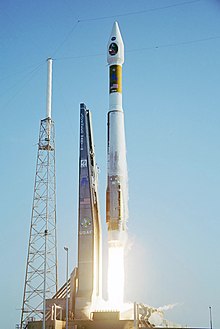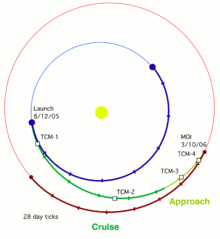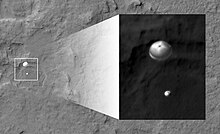Mars Reconnaissance Orbiter
| Mars Reconnaissance Orbiter | ||||||||||||||||||||||
|---|---|---|---|---|---|---|---|---|---|---|---|---|---|---|---|---|---|---|---|---|---|---|
 The MRO in a Mars orbit (artist's impression) |
||||||||||||||||||||||
| NSSDC ID | 2005-029A | |||||||||||||||||||||
| Mission goal | Mars | |||||||||||||||||||||
| Client |
|
|||||||||||||||||||||
| Launcher | Atlas V (401) | |||||||||||||||||||||
| construction | ||||||||||||||||||||||
| Takeoff mass | 2180 kg | |||||||||||||||||||||
| Instruments | ||||||||||||||||||||||
|
HiRISE, CTX, MARCI, CRISM, MCS, SHARAD, Electra |
||||||||||||||||||||||
| Course of the mission | ||||||||||||||||||||||
| Start date | August 12, 2005, 11:43 UTC | |||||||||||||||||||||
| launch pad | Cape Canaveral , LC-41 | |||||||||||||||||||||
|
||||||||||||||||||||||

The Mars Reconnaissance Orbiter ( MRO , English for Mars-sensing satellite ) is a NASA - spacecraft to explore the planet Mars , which departed on 12 August 2005 to the Red Planet, reaching their destination on March 10 of 2006.
Since the probes Viking 1 and Viking 2 from 1975 the Viking -Programms she was the heaviest US Mars probe. At take-off it weighed over 2 tons (with propulsion and fuel). The total cost of the mission was approximately $ 720 million, of which $ 450 million was for the development and manufacture of the probe and its instruments, $ 90 million for the launcher, and $ 180 million for the five and a half year planned primary mission.
With the arrival of MRO on Mars, together with Mars Global Surveyor , Mars Odyssey and Mars Express , four orbiters were active simultaneously in Mars orbit for the first time.
Mission objectives
The primary aim of the probe is to map the surface of Mars: the Mars Reconnaissance Orbiter brings the camera with the highest resolution to date into a Mars orbit. It achieves an improved horizontal image resolution of one meter per pixel , while earlier recordings still had several meters per pixel. Due to the limitation of the amount of data that can be transmitted to Earth, only selected parts of the planet can be captured with the highest resolution.
The recordings should also reveal smaller geological structures, e.g. B. hydrothermal springs , in the vicinity of which ( fossil ) life is suspected. They also enable a more targeted selection of interesting landing sites for further Mars missions, such as the Phoenix probe, which arrived on Mars on May 25, 2008, and the Mars Science Laboratory in August 2012.
The MRO also uses radar to search for water and ice just below the Martian surface, especially on the polar caps. After all, the probe will serve as a relay station for future landing missions .
technology
The Mars Reconnaissance Orbiter was originally supposed to be launched with an Atlas III rocket and have a launch mass of 1,975 kg. But after the newer Atlas V rocket had successfully completed its maiden flight in 2002, it was decided to launch the probe with it, as it allows more payload for the price of an Atlas III . As a result, the launch mass of the probe rose to 2,180 kg, the empty weight of the probe being 1,031 kg (of which 139 kg are instruments) and 1,149 kg is accounted for by the fuel to be carried . The load-bearing structure of the probe without devices weighs 220 kg and consists of light but strong materials such as titanium , carbon fiber composites and aluminum in a sandwich honeycomb core construction . The structure must be able to withstand starting accelerations of 5 g , which corresponds to five times the weight of the probe itself (i.e. 10,900 kg).
power supply
The power supply for the orbiter is provided by two solar collectors, each 5.35 m long and 2.53 m wide. The solar collectors can be moved up and down as well as rotated around their own axis independently of each other. On the front of each collector, an area of 9.5 m² is covered with 3,744 individual solar cells . The very efficient triple-junction solar cells have an efficiency of 26%, i.e. that is, they can convert 26% of the energy in incident sunlight into electricity. The solar cells are connected in such a way that they supply a constant voltage of 32 V, for which the probe's instruments are designed. The total energy yield of the two solar collectors in Mars orbit is around 2,000 watts (in Earth orbit the energy yield would be 6,000 watts due to the shorter distance to the sun).
The Mars Reconnaissance Orbiter has two rechargeable nickel-metal hydride batteries with a capacity of 50 Ah (ampere hours) each on board. The accumulators are used for power supply during the flight phases, in which the solar collectors do not provide any electrical energy. This happens, for example, during take-off, when swiveling into Mars orbit, during aerobraking maneuvers or when the probe enters the Martian shadow. Since the available voltage drops as the batteries continue to discharge and the on-board computer switches off when the voltage drops to around 20 V, the probe can only use around 40% of the battery capacity.
electronics
The heart of the MRO-board computer is faster, a 133 MHz, from 10.4 million transistors existing, 32-bit rad750 - processor . The processor is a radiation- hardened version of the PowerPC-750 G3 and a successor to the RAD6000 processor, which is used, for example, in the Mars rovers Spirit and Opportunity . At the time the probe was built, it was the fastest processor that - far removed from the protection of the magnetic field and the Earth's atmosphere - can still work reliably.
For data storage, the MRO has 20 GB, which are distributed over more than 700 individual flash memory chips with a capacity of 256 Mbit each (= 32 MB). The storage capacity of the probe is not particularly high compared to an image from the HiRISE camera, which can be up to 3.5 Gbytes in size.
The onboard computer uses VxWorks - real-time operating system one that is already in many space missions such. B. in Spirit and Opportunity , was used.
communication
For communication with the earth, the MRO has a directional antenna (High Gain Antenna - HGA) with a diameter of three meters, with which data transmission rates of up to 6 Mbit / s can be achieved. The antenna is movable and can be precisely aligned with the earth. The probe transmits in the X-band at a frequency of 8 GHz with a power of 100 watts, and experimental communication in the Ka-band with 32 GHz and 35 watts is planned. A higher data transmission rate can be achieved with the higher transmission frequency. Should communication in the Ka-band prove successful, future space probes will be equipped with the new transmission technology. The probe has two amplifiers for the X-band (the second is in case the first fails) and one amplifier for the Ka-band. After the end of the primary mission, the antenna is said to have transmitted around 34 terabits of scientific data to Earth (this is more than the amount of data from all previous planetary space probes combined), with data being transmitted for around 10-11 hours per day at an average data rate of 0.6 to 5 Mbit / s (depending on the distance from Earth to Mars) takes place. The receiver on earth is a 34 m DSN antenna. For comparison: The transmitters on MGS and Odyssey had / have an electrical output of 25/15 W and a data transmission rate of 20–80 / 14–120 kbit / s - more than an order of magnitude less than MRO.
In the event that the directional antenna cannot be used, the MRO has two low-gain antennas (LGA). The antennas are on the HGA dish, one on the front and one on the back. In order to communicate with the earth, the low-gain antennas do not need to be aligned, but only achieve low data rates. Since the probe has two of these antennas (one each covers a full hemisphere), it can both send and receive signals from any position. The antennas are used during take-off and when entering Mars orbit, but also serve to secure communication in an emergency.
The MRO also has an Electra - UHF communication system with which the probe can communicate with other Mars probes, both with the Phoenix lander and, since 2012, with the Mars Science Laboratory. This allows the landing emission data to be forwarded to earth by the MRO. In addition, the precise position of the lander on the surface of Mars can be determined by measuring signal transit times.
Drive system
The MRO uses a propulsion system that burns catalytically decomposed hydrazine as the only fuel and therefore does not carry an oxidizer . The probe's titanium tank with a volume of 1,175 liters can hold a maximum of 1,187 kg of fuel, but only 1,149 kg of fuel are carried in order not to exceed the maximum payload of the launcher. This amount of fuel would be enough to change the speed of the probe by 1,551 m / s. More than 70% of the fuel was consumed when entering Mars orbit, as the probe had to be braked heavily in order to be captured by the gravitational pull of Mars. To put the fuel under pressure, helium gas is used, which is stored in a separate, high-pressure tank.
The probe's drive system consists of 20 thrusters in three different sizes:
- Six large MR-107N engines, each generating 170N of thrust (1,020N in total). These engines are used for the first course correction maneuver and for launching into orbit around Mars.
- Six medium-sized MR-106E engines, each generating 22N of thrust. These engines are used to correct the flight path and to keep the probe on the correct course when it is launched into Mars orbit.
- Eight small MR-103D engines, each generating 0.9N of thrust. They are used for the attitude control of the MRO both during normal operation time and during entry into orbit of Mars and during flight path corrections.
In addition, four reaction wheels are used for precise position control , especially for high-resolution recordings, where even the smallest movement causes blurring in the image. Each wheel is used for one axis of movement, the fourth wheel is used as a reserve should one of the other three fail. A single twist wheel weighs 10 kg and can rotate at up to 6,000 revolutions per minute.
Navigation systems and sensors provide information on the position, course and orientation of the probe during flight. This data is crucial to be able to perform accurate maneuvers on the way to Mars and to keep the solar panels aligned with the sun and around the antenna with the earth. In addition, the position of the probe must be controlled very precisely in order to be able to take blurry high-resolution images of the surface of Mars. The navigation system has several sensors and instruments for this purpose :
- 16 sun sensors (eight of which are intended as a reserve) are arranged on all sides of the probe. The sensors are very simple and only provide the answer as to whether they see the sun or not. The computer then uses the data from individual sensors to calculate the approximate position of the sun. If the probe loses its orientation, these sensors are sufficient to align the solar collectors with the sun and thus guarantee the power supply. However, they cannot be used to precisely align the probe with Earth and Mars.
- Two star trackers (one serves as a reserve) of the A-STR brand from Galileo Avionica for precise alignment with the sun as well as the earth and Mars. A star tracker is a small camera that takes digital images of the stars. These images are compared with the data of thousands of stars stored in the on-board computer. Once the Star Tracker has identified the stars in the image, the computer knows exactly where and in which direction the probe is. The Star Tracker takes ten pictures per second.
- Two Miniature Inertial Measurement Units (MIMU) (one serves as a reserve) from Honeywell , each consisting of three gyroscopes and three accelerometers . One gyroscope and one accelerometer are used for each axis of movement. The gyroscopes are used to measure the rotational speed of the probe (e.g. when turning for position control) and the accelerometers to measure the acceleration (e.g. when firing engines). In addition, in the Atmospheric Structure Investigation Accelerometer experiment, the accelerometer is used to measure the braking effect of the upper layers of the atmosphere during aerobrakings . This provides information about the density and structure of the upper atmosphere.
In addition, with the Optical Navigation Camera , the MRO has an experiment for optical navigation for a more precise entry into the orbit of Mars. To this end, the Mars moons Phobos and Deimos are photographed 30 to two days before the probe arrives on Mars in order to determine the exact position of the probe. The Optical Navigation Camera is not necessary for the MRO to enter orbit safely. However, if this experiment yields positive results, this type of navigation will be used in future landing missions, which must arrive at Mars with a very high degree of precision in order not to miss the very precisely defined landing sites.
Instruments
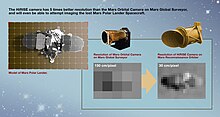
On board the MRO there are six scientific instruments as well as some technical experiments, such as the Ka-band communication, the Electra communication system and the optical navigation camera. The technical experiments were described in the section Technology , here the scientific instruments are presented.
- High Resolution Imaging Science Experiment (HiRISE)
- The largest and most important instrument on board the Mars Reconnaissance Orbiter is the HiRISE, which consists of a high-resolution photo camera with a Cassegrain telescope 1.40 m long and 50 cm in diameter. HiRISE is the second high-resolution stereo camera of a Mars probe after HRSC from Mars Express. The telescope contains three mirrors and has a field of view of 1.14 ° × 0.18 °. The camera weighs about 65 kg and is capable of producing images from a height of 300 km with a maximum vertical resolution of 20–30 cm per pixel. Three spectral bands are available for the recordings: blue-green BG (400–600 nm), red (550–850 nm) and near-infrared NIR (800–1,000 nm). A 6 km wide strip is recorded in the red band, and 1.2 km wide in BG and NIR. The length of the captured image is about twice its width. To capture the incident light, HiRISE contains a total of 14 detector chip assemblies (DCA), each of which houses a CCD module with the associated control electronics. Each CCD module consists of 2,048 12 × 12 µm pixels across the direction of flight and 128 TDI elements along the direction of flight. The TDI elements (Time Delay and Integration) are used to improve the signal-to-noise ratio. For the BG and NIR bands, two DCAs with a total of 4,048 pixels are available for each band. For the red band there are ten DCAs with a total of 20,264 pixels. A lookup table can be used for real-time data compression , which transforms 14-bit signals recorded with the camera into 8-bit signals. A lossless 2: 1 compression method is also available. A typical high resolution image from the HiRISE camera is 20,000 × 40,000 pixels (i.e. approx. 800 megapixels) and it takes 4 to 48 hours to transmit to Earth, depending on the Earth-Mars distance and the compression factor. The camera has an internal 28 GBit memory for buffering the recordings before they are forwarded to the on-board computer. The development costs for HiRISE were approximately $ 35 million. The instrument was built by Ball Aerospace for the University of Arizona .
- Context Imager (CTX)
- CTX is also a camera that generates grayscale images in visible light with a wavelength of 500 to 800 nm and works with a lower resolution of around six meters. Its purpose is to map parts of Mars, but above all to be able to correctly insert the data from the high-resolution HiRISE camera and the CRISM spectrometer into the global context. CTX has a Maksutov telescope with a focal length of 35 cm and a 6 ° field of view; a CCD line array consisting of 5064 pixels is used for recording . A typical picture is about 30 km away. The instrument has a 256 MB DRAM memory, which is sufficient to store a 160 km long image internally before it is transferred to the main memory of the probe. The instrument was built at Malin Space Science Systems .
- Mars Color Imager (MARCI)
- MARCI consists of a wide-angle camera and a telecamera, which are mainly used to study the Martian atmosphere. MARCI is a copy of the camera that was lost with the Mars Climate Orbiter in 1999 , only the lens of the camera was replaced by a larger fisheye lens with a 180 ° angle of view to compensate for the roll movements of the space probe, which are necessary to operate other instruments. The cameras are connected to shared electronics and have seven spectral channels, five of which in visible light at wavelengths of 425, 550, 600, 650 and 725 nanometers and two in UV light at 250 and 320 nanometers. With the instrument, surface changes such as sand movements or the changing dimensions of the polar ice caps are to be registered. B. for ozone , are searched. MARCI is also used to provide daily weather reports from across the planet. The instrument was built at Malin Space Science Systems.
- Compact Reconnaissance Imaging Spectrometer for Mars (CRISM)
- CRISM is a spectrometer with which the entire surface of Mars is scanned for occurrences of different minerals . For this purpose, CRISM has 544 different spectral channels, which can be used to search for specific minerals. The main focus here is on the minerals that can arise in contact with water , such as B. hematite . CRISM is initially to scan the entire surface of Mars with a resolution of 100–200 m and in around 70 spectral channels in order to then be able to select areas that are recorded with a higher resolution (up to 18 m maximum). The spectrometer has a telescope with a 10 cm aperture and 2 ° field of view, with which images of the Martian surface with a width of about 10 km are recorded. The instrument records the light intensities in the spectral band at wavelengths from 370 to 3,940 nm, this band being divided into strips 6.55 nm wide. The cost of developing this instrument was $ 17.6 million. The instrument was developed by the Applied Physics Laboratory at Johns Hopkins University .
- Mars Climate Sounder (MCS)
- MCS is an experiment to study the Martian atmosphere and serves as a replacement for instruments with similar objectives that were lost in the Mars Observer and Mars Climate Orbiter missions . MCS has two telescopes with apertures of 4 cm. In contrast to other instruments, which all look straight down, the telescopes of the MCS are aimed at the horizon in normal operation, but can also be rotated in other directions. MCS has nine spectral channels and is designed to study the distribution of dust and water vapor in the atmosphere. In addition, changes in air temperature and pressure are recorded. One of the nine channels covers the frequencies of visible and near-infrared light at a wavelength of 300 to 3,000 nm. The other eight channels are in the thermal infrared range of the electromagnetic spectrum at wavelengths from 12 to 50 µm. A three-dimensional map of the Martian atmosphere with dust, water vapor, pressure and temperature distributions up to an altitude of 80–100 km is to be created from the data from the MCS. The instrument was developed by the Jet Propulsion Laboratory .
- Shallow Radar (SHARAD)
- The SHARAD experiment is to use ground penetrating radar to search for water and / or ice deposits below the surface of Mars. SHARAD is the successor to the MARSIS experiment used on the European Mars Express space probe launched in 2003 . However, since it works with frequencies of 15-25 MHz in a slightly different frequency range, the results of both devices can complement each other. SHARAD can penetrate from 100 meters to one kilometer deep into the Martian crust, has a horizontal resolution of 0.3–1 km along the direction of flight and 3–7 km across the direction of flight, and a vertical resolution of 7 m. This means that the object must have at least these dimensions in order to be observable. With SHARAD it should be possible to find water deposits below the surface of Mars down to a depth of 100 m. The instrument was developed by Alenia Spazio on behalf of the Italian Space Agency (ASI).
Course of the mission
The first proposals to send an orbiter equipped with a powerful camera to Mars in 2003 appeared at NASA in 1999. The spacecraft, tentatively named Mars Surveyor Orbiter, was intended to both obtain the scientific data expected from the lost Mars Climate Orbiter and also search for traces of water on Mars. The probe was supposed to be about the size of the Mars Global Surveyor launched in 1996 and could therefore have been manufactured and launched relatively cheaply. The launch of a larger Mars rover was also targeted for the same launch window. In July 2000, NASA finally decided to give preference to the rover project and to send the rover to Mars in 2003 (which later became the dual mission of the two rovers Spirit and Opportunity ). The start of the orbiter was then postponed by two years to 2005 and its mission was expanded: a larger and correspondingly more expensive orbiter, equipped with powerful instruments, should now be developed. The new project called Mars Reconnaissance Orbiter started in autumn 2000. In October 2001, Lockheed Martin received an order from NASA to build the probe.
begin
The Mars Reconnaissance Orbiter was on 10 August 2005 with an Atlas V - launch vehicle from Cape Canaveral from start. Due to technical problems with the launcher, the launch was initially postponed to August 11th. This start date could not be kept due to problems with the Centaur upper level. The launch took place on the third attempt on August 12 at 11:43 a.m. UTC . The spacecraft was disconnected from the Centaur 57 minutes and 54 seconds after launch, and contact with the probe could be made three minutes later via a Japanese antenna in the Uchinoura Space Center . 14 minutes after disconnection, the large solar collectors were successfully extended.
Flight phase (August 2005 to March 2006)
After the successful start and activation, the probe was switched to "cruise mode", which it was in until about two months before arrival on Mars. This phase of the mission included daily monitoring of the subsystems of the probe, determination and correction of the flight path, and testing and calibration of the instruments. On August 15th, the MARCI instrument was tested, for which images of the earth and the moon were made. Tests of the HiRISE, CTX and Optical Navigation Camera followed on September 8, for which the instruments looked back at the moon, which is now 10 million kilometers away. All tests were successful.
The approximately 500 million kilometers long journey to Mars took about seven months. In order to steer the spacecraft on its way, five course correction maneuvers were planned. The first 15-second maneuver (TCM-1) took place on August 27, 2005 using all six large 170N engines. Previously, six smaller engines fired for 30 seconds to position the fuel in the tank for better flow. During the maneuver a speed change of 7.8 m / s was achieved. The remaining course corrections use the smaller 22 N engines, with the second course correction maneuver (TCM-2), which lasted 20 seconds, took place on November 17th and achieved a speed change of 0.75 m / s. The third course correction maneuver (TCM-3) was supposed to take place 40 days before arrival, but was canceled because the probe was already on an optimal course. The fourth course correction maneuver (TCM-4) was scheduled for February 28, but was also canceled for the same reason. The optional fifth maneuver (TCM-5), which should take place 24 to six hours before entering Mars orbit, has also been canceled.
Arrival and braking maneuvers
In order to enter Mars orbit ( Mars Orbit Insertion , MOI ), the large engines of the probe should be ignited on March 10, 2006 from 21:24 to 21:51 UTC for about 26.8 minutes (1,606 seconds). However, due to an unexpectedly lower performance of the engines, the MRO's computer had to extend the burn process by 35 seconds. Since the space probe was behind Mars at the end of the braking maneuver and therefore could not communicate with Earth, there was a signal from the probe at 11:16 p.m. and a few minutes later the confirmation of successful entry into Mars orbit. During the braking maneuver, the speed of the probe was reduced by 1000.48 m / s (approx. 18% of the approach speed) - the plan was 1000.36 m / s - so that it was captured by the gravitational pull of Mars and converted into an elliptical 426 × Entered orbit for 43,500 kilometers. The first test images from the spacecraft's HiRISE camera were received on March 24th. The expectations were absolutely met. From a distance of 2,489 km, which is far beyond the later working distance, images with a resolution of 2.5 m per pixel were obtained. After further test images on March 25, the camera was switched off until the beginning of the scientific work in November 2006. At the same time, the context imager and the Mars color imager were tested, although the images obtained were not published until later.
Mars orbit using aerobraking
The aerobraking maneuvers in the Martian atmosphere began on March 30, 2006 , whereby the orbit was to be gradually reduced to an approximately 255 × 320 km high, almost polar sun-synchronous orbit with an orbit time of 112 minutes. For this purpose, the probe's MR-106E engines were ignited for 58 seconds, reducing the point of orbit closest to Mars to 333 km. Further braking maneuvers brought the lowest point of the orbit within the very thin upper Martian atmosphere, which exerted a further braking effect on the orbiter. The two large solar panels of the MRO were brought into a position in which they generated greater air resistance. In order not to endanger the space probe by the heat generated by air friction, each individual immersion process was only allowed to last a limited time and thus only reduce the flight speed by a fraction. Therefore, at the beginning of the mission, the number of necessary immersion processes was estimated at around 500. Aerobraking saved around 600 kg of fuel, which MRO would otherwise have to carry in order to reach the same target orbit with the help of its engines alone.
The aerobraking maneuvers were successfully completed on August 30, 2006 after 426 immersions in the atmosphere. On that day, the spacecraft fired its MR-106E engines for six minutes, bringing it to the point of orbit closest to Mars at 210 km, which is well above the upper limit of the atmosphere (during the aerobrakings it was 98 to 105 km on average) . Another orbit correction maneuver followed on September 11th - and with a burning time of 12.5 minutes the longest after Mars orbit insertion - orbit correction maneuver, which brought the orbit height to 250 × 316 km and the lowest point of the orbit near the South Pole and the highest one nearby of the North Pole.
On September 16, 2006, the 10 m antenna of the SHARAD radar was deployed (a similar operation caused numerous problems with the European Mars Express spacecraft ). The removal of the protective cover and the calibration of the CRISM instrument followed on September 27th.
On October 3, the HiRISE camera took pictures of the Victoria Crater, at the edge of which the Opportunity Rover was at the time . The high-resolution images clearly show the rover and its traces in the Martian soil, even the shadow of the rover camera mast is visible.
From October 7th to November 8th 2006 the planet Mars was in a solar conjunction . During this period, the sun was directly between Mars and Earth, so that only limited communication between the orbiter and Earth could take place. After the sun conjunction, the Mars Reconnaissance Orbiter was subjected to further smaller functional tests and has been available for scientific work since November 2006.
Primary Mission (2006-2010)

The probe's primary mission to Mars lasted four years, of which Mars was mapped with the HiRISE camera and examined with the other instruments during the first two years from November 2006 to December 2008. For the next two years, it was planned that the orbiter would serve as a platform for communication between future landing missions and Earth. According to researchers at the Institute of Planetology at the University of Münster, recordings of an erosion channel on the dune slope of the so-called Russell Crater, which were made between November 2006 and May 2009, provide evidence that there is liquid water on Mars at certain times of the year. In August 2009 the orbiter went into safety mode after problems with the software. On December 8, 2009, NASA then succeeded in returning the probe to its normal operating state after updating the software in several stages. On May 19, 2010, HiRISE was able to photograph an impact crater that did not exist during the previous overflight in March 2008. During the impact, water ice close to the surface was exposed. Another photo may show the parachute of Mars 3 , a Soviet space probe that was supposed to explore Mars using a lander in 1971.
The primary mission ended on December 31, 2010. After the end of the primary mission, the on-board fuel should be sufficient to operate MRO as a communication platform for at least another five years.
After the end of the primary mission
On August 6, 2012, the HiRISE camera of the Mars Reconnaissance Orbiter photographed the landing of the Mars Science Laboratory ("Curiosity" rover).
In January 2015, the unknown landing site of Beagle 2 at the position 11.5 ° North and 90.4 ° East could be located on photos of the HiRISE camera of the MRO from June 29, 2014 . The picture shows the obviously gently landed probe, the solar panels of which are at least partially open. The parachute and a cover could also be identified in the immediate vicinity.
See also
Web links
- NASA Mars Reconnaissance Orbiter website
- Press material on NASA's MRO launch (PDF; 0.2 MB; English)
- Website of the HiRISE camera (english)
- Mars Reconnaissance Orbiter by Bernd Leitenberger
Individual evidence
- ↑ Atlas III Chosen to Launch Mars Reconnaissance Orbiter . NASA, June 11, 2002
- ^ Mars Reconaissance Orbiter: Electra . NASA
- ↑ a b Mars Reconnaissance Orbiter Design Approach for High-Resolution Surface Imaging (PDF; 4.5 MB), American Astronautical Society, 2003
- ^ Mars Reconaissance Orbiter: Optical Navigation Camera . NASA
- ↑ a b Sixth International Conference on Mars (2003): HiRISE: Instrument Development (PDF; 1.4 MB)
- ↑ HiRISE website
- ↑ Mars Reconnaissance Orbiter (MRO) Context Camera (CTX) . Malin Space Science Systems
- ↑ CTX . NASA
- ^ Mars Color Imager (MARCI). Malin Space Science Systems
- ↑ APL: Compact Reconnaissance Imaging Spectrometer for Mars (CRISM) ( Memento from May 4, 2006 in the Internet Archive )
- ↑ MRO Spacecraft and Instruments - Mars Climate Sounder (MCS) . NASA
- ^ SHARAD website ( Memento of May 22, 2009 in the Internet Archive )
- ↑ SHARAD: The MRO 2005 shallow radar ( Memento from September 6, 2005 in the Internet Archive ) (PDF) Planetary and Space Science
- ↑ NASA Identifies Two Options For 2003 Mars Missions; Decision in July . NASA, May 20, 2000
- ^ NASA Goes Back to the Future With Plans for a Mars Rover in 2003 . NASA, July 27, 2000
- ^ NASA Unveils Plans for 21st Century Mars Campaign ( Memento December 10, 2004 in the Internet Archive ). Space.com, October 26, 2000
- ↑ NASA Picks Lockheed Martin to Build 2005 Mars Craft ( Memento from February 12, 2006 in the Internet Archive ). Space.com, October 3, 2001
- ↑ NASA's Multipurpose Mars Mission Successfully Launched . NASA, August 12, 2005
- ↑ a b NASA's Mars Reconnaissance Craft Begins Adjusting Orbit . NASA, March 31, 2006
- ↑ NASA's New Mars Orbiter Returns Test Images . NASA, March 24, 2006
- ↑ Mars Cameras Debut as NASA Craft Adjusts Orbit . NASA, April 13, 2006
- ↑ a b NASA Mars Reconnaissance Orbiter Reaches Planned Flight Path . NASA, September 12, 2006
- ^ Mars Reconnaissance Orbiter Successfully Concludes Aerobraking . NASA, August 30, 2006
- ↑ Ground-Piercing Radar on NASA Mars Orbiter Ready for Work . JPL / NASA, September 19, 2006
- ↑ APL-Built Mineral Mapping Imager Begins Mission at Mars . ( Memento of October 27, 2006 in the Internet Archive ) APL, September 27, 2006
- ↑ NASA's Mars Rover and Orbiter Team Examines Victoria Crater . NASA, October 6, 2006
- ↑ Liquid water on Mars . Scinexx.de, April 29, 2010
- ↑ MRO is healthy again . In: FlugRevue , February 2010, p. 74
- ↑ Icy material Thrown from cratering Impact on Mars. NASA, October 12, 2013
- ↑ Possible Parachute From 1971 Soviet Mars Lander. NASA, November 4, 2013
- ↑ Components of Beagle 2 Flight System on Mars jpl.nasa.gov . NASA, Jan. 16, 2015




